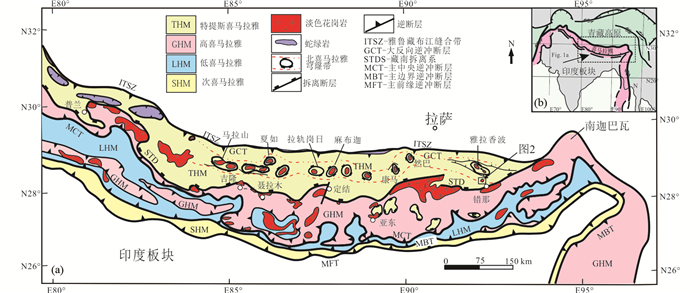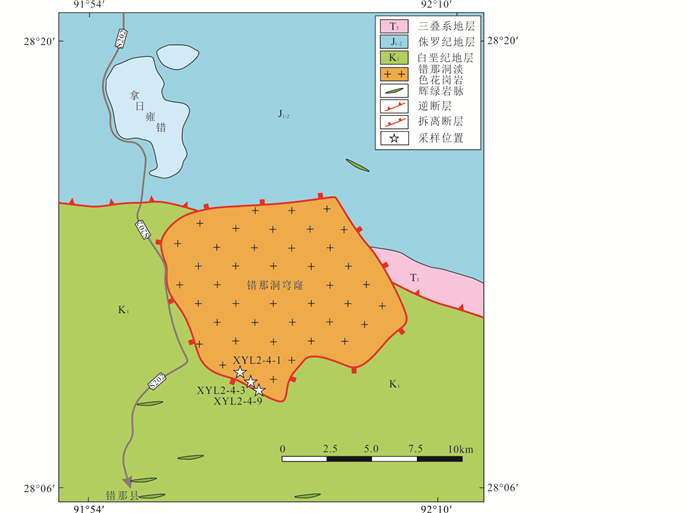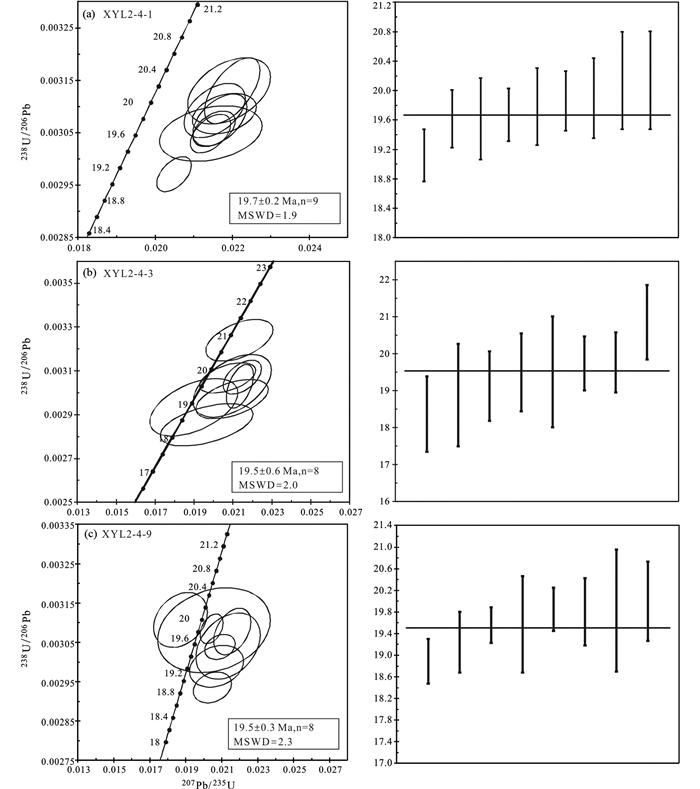2. 南京大学地球科学与工程学院, 内生金属矿床成矿机制研究国家重点实验室, 南京 210046;
3. 中国地质调查局青岛海洋地质研究所, 青岛 266071
2. State Key Laboratory for Mineral Deposits Research, Department of Earth Sciences, Nanjing University, Nanjing 210046, China;
3. Qingdao Institute of Marine Geology, China Geological Survey, Qingdao 266071, China
印度与欧亚大陆碰撞是新生代地球上最为壮观的重大地质事件。碰撞以来,青藏高原的广大地域发生了与碰撞前截然不同的变形、地貌、环境及其深部结构的变化(许志琴等, 2011),两大陆碰撞的最直接结果就是强烈的构造变形、岩浆作用、变质作用及喜马拉雅碰撞造山带的形成(Tapponnier et al., 1986; Yin, 2006; Xu et al., 2013; 许志琴等, 2011)。
在喜马拉雅造山带的最北部—特提斯喜马拉雅岩片内发育一条平行于造山带展布的由一系列形状不同、规模不一的穹窿所组成串珠状穹隆带(图 1),如康马穹窿、雅拉香波穹窿等,部分学者称其为拉岗轨日穹窿(李德威等, 2003),也有学者将其命名为北喜马拉雅片麻岩穹窿带(NHGD)(Zhang et al., 2012)。穹窿带内保存了大陆碰撞后青藏高原中下地壳的构造变形、高级变质、陆壳深熔作用等重要信息,是研究喜马拉雅造山带的深部岩浆作用和构造变形之间的耦合关系、碰撞阶段构造变形、深部岩浆活动乃至青藏高原构造隆升历史等大陆动力学过程的关键部位(张进江等, 2011)。

|
图 1 喜马拉雅造山带地质简图(据Xu et al., 2013修改) Fig. 1 Simplified geologic map of the Himalayan orogen (modified after Xu et al., 2013) |
错那洞穹窿位于雅拉香波穹窿南侧,前人的研究仅限于构造变形(Fu et al., 2017)和岩石成因(林彬等, 2016),对于该穹窿的形成机制、演化过程仍待进一步研究。
为此,本文选择藏南地区错那洞穹窿内淡色花岗岩为研究对象,通过锆石U-Pb和云母40Ar/39Ar年代学和岩石地球化学研究,探讨岩浆侵位和冷却过程,为研究STDS的形成机制提供依据。
2 地质背景喜马拉雅主碰撞造山带宽300~500km,位于印度斯-雅鲁藏布江缝合带(IYSZ)和喜马拉雅主前锋冲断裂(MFT)之间,呈向南突出的E-W向弧形展布,长2500km(图 1)。自北往南共分为四部分:特提斯喜马拉雅岩片(THM)、高喜马拉雅岩片(GHM)、低喜马拉雅岩片(LHM)及次喜马拉雅岩片(SHM),其间分别以藏南拆离系(STDS)、主中央冲断裂(MCT)、主边界冲断裂(MBT)和主前锋冲断裂(MFT)为界(Burg and Chen, 1984; Burchfiel et al., 1992; Brookfield, 1993; Yin and Harrison, 2000)。
THM被公认为是印度大陆北部的被动大陆边缘沉积盆地类型(Liu and Einsele, 1994),主要发育古生代至始新世经历低级变质的硅质碎屑岩和碳酸盐岩组成,其中夹杂中生代火山岩(Brookfield, 1993)。GHM南北分别被MCT和STDS所围限,主要由古元古代-奥陶纪的中高级变质结晶杂岩系组成(Aikman et al., 2008),其上部靠近STDS处出露大量淡色花岗岩,形成GHM淡色花岗岩带。STDS是THM与GHM的重要边界,其活动时间为~23Ma(Hodges et al., 1996)和~15Ma(Searle et al., 1999),与MCT同时形成(Hubbard and Harrison, 1989; Searle and Rex, 1989; Burchfiel et al., 1992; Hodges et al., 1992, 1996)。已有研究表明,STDS向北延至特提斯喜马拉雅的北喜马拉雅穹窿带(Chen et al., 1990; Burchfiel et al., 1992; Steck et al., 1998; Edwards et al., 1999; Hodges, 2000; Aoya et al., 2005, 2007; Lee et al., 2006; Zhang et al., 2012)。
在北喜马拉雅片麻岩穹窿带(NHGD)内,除个别穹窿核部出露寒武纪花岗岩外,如:康马穹窿(Lee et al., 2000; Schärer et al., 1986)和Kampa穹窿(Quigley et al., 2008),其他穹隆核部主要由新生代淡色花岗岩及二云母花岗岩、片麻岩及片岩组成,边部覆以浅变质的特提斯喜马拉雅岩系,而核部与边部之间以伸展拆离断层接触(张进江等, 2007)。
本文所研究的错那洞穹隆位于错那县北约20km(图 2),属于STDS的上盘位置,从穹窿的核部至边部依次为:淡色花岗岩、高级变质岩以及浅变质的特提斯喜马拉雅岩系(Fu et al., 2017)。核部的错那洞淡色花岗岩呈菱形展布(图 2),东西向比南北向略长,岩石总体呈灰白色主要由含白云母(石榴石)淡色花岗岩(图 3a, b)和巨斑花岗岩(图 3c, d)组成。含白云母(石榴石)淡色花岗岩呈中粒花岗结构,主要矿物为石英(35%)、斜长石(30%)、钾长石(15%)、白云母(10%)(图 3b),次要矿物为石榴石和电气石,副矿物为锆石、磷灰石等。巨斑花岗岩呈似斑状结构(图 3c),长石斑晶自形程度较好,呈板状,粒径可达5~10cm,主要由石英(40%)、斜长石(50%)、白云母(10%)等矿物(图 3d)。

|
图 2 藏南错那洞花岗岩穹窿地质简图(据尹光候等,2004①) Fig. 2 Simplified geologic map of the Cuonadong dome, southern Tibet |
① 尹光候, 苏学军, 黄建国等(云南省地质调查院矿产调查所). 2004.西藏1:25万隆子县幅区域地质图(H46C004002)

|
图 3 错那洞淡色花岗岩野外和镜下特征 (a、b)淡色花岗岩;(c、d)巨斑状花岗岩 Fig. 3 Macro-photograph and micro-photographs of the Cuonadong leucogranite (a, b) leucuogranite; (c, d) large-porphyritic granite. Pl-plagioclase; Kf-K-feldspar; Qtz-quartz; Mus-muscovite; Grt-garnet |
锆石分选在廊坊市科大岩石矿物分选技术服务有限公司完成,采用常规粉碎、浮选和电磁选方法进行分选。锆石阴极发光(CL)照相在北京锆年领航科技有限公司电子探针实验室采用扫描电镜完成,加速电压为15kV。锆石U-Pb同位素测年在吉林大学东北亚矿产资源评价国土资源部重点实验室完成,激光剥蚀使用德国相干公司(Coherent)COMPExPro型ArF准分子激光器,质谱仪为美国安捷伦公司7500A型四极杆等离子质谱。激光条件为:激光束斑直径32μm,激光能量密度10J/cm2,剥蚀频率8Hz。剥蚀样品前首先采集30s的空白,随后进行30s的样品剥蚀,剥蚀完成后进行2min的样品池冲洗。载气使用高纯度He气,气流量为600mL/min;辅助气为Ar气,气流量为1.15L/min。对于不用同位素的采集时间,204Pb、206Pb、207Pb和208Pb为20ms,232Th、238U为15ms,49Ti为20ms,其余元素为6ms。使用标准锆石91500(1062Ma)作为外标进行同位素比值校正,标准锆石PLE/GJ-1/Qing Hu为监控盲样。元素含量以国际标样NIST610为外标,Si为内标元素进行计算,NIST612和NIST614为监控盲样。使用Glitter软件进行同位素比值及元素含量的计算。谐和年龄及图像使用Isoplot/Ex(3.0)给出(Ludwig, 2003)。普通铅校正使用Andersen给出的程序计算(Andersen, 2002)。分析数据及锆石U-Pb谐和图给出误差为1σ,表示95%的置信度。测试结果见表 1。
|
|
表 1 藏南错那洞穹窿淡色花岗岩锆石LA-MC-ICP-MS U-Pb测年分析数据 Table 1 LA-MC-ICP-MS U-Pb zircon data of the leucogranite samples from the Luozha area, southern Tibet |
Ar-Ar同位素年龄测定是在中国地质科学院地质研究所氩-氩实验室完成,用GV Helix MC质谱仪测定样品中释放的氩气体组成。用于Ar-Ar同位素定年的样品破碎后经重液浮选和磁选,选出白云母初级样品,之后在显微镜下经手工仔细挑选,因此样品纯度在99%以上,最后用超声波清洗。清洗后的样品被封进石英瓶中送核反应堆中接受中子照射。照射工作在中国原子能科学研究院的“游泳池堆”中进行,同时用标样(ZBH-25黑云母标样)对接受中子照射样品进行监控,标样中K的含量为7.6%,其标准年龄为137.2±1.2Ma。
样品的阶段升温加热是在石墨炉中完成,每一个阶段需加热30min,净化30min。用多接收稀有气体质谱仪Helix MC进行质谱分析,每个峰值均采集20组数据。所有数据在回归到时间零点值之后分别进行质量校正,如:歧视校正、大气氩校正、空白校正和干扰元素同位素校正。中子照射过程中所产生的干扰同位素校正系数通过分析照射过的K2SO4和CaF2来获得,其值为:(36Ar/37Ar0)Ca=0.0002389,(40Ar/39Ar)K=0.004782,(39Ar/37Ar0)Ca=0.000806。37Ar经过放射性衰变校正;40K衰变常数λ=5.543×10-10a-1;坪年龄误差以2σ给出,详细实验流程见有关文献(陈文等, 2002; Chen et al., 2002)。测试结果见表 2。
|
|
表 2 藏南错那洞穹窿淡色花岗岩锆石白云母40Ar/39Ar测年分析数据 Table 2 Muscovite 40Ar/39Ar data of the leucogranite sample from the Luozha area, southern Tibet |
对错那洞淡色花岗岩(XYL2-4-1和XYL2-4-3)和巨斑花岗岩(XYL2-4-9)分别进行锆石LA MC-ICP-MS U-Pb年代学测定。阴极发光(CL)图像显示(图 4),两类岩石锆石特征基本一致,大部分锆石为自形-半自形、长柱状,粒度在50~250μm之间,长宽比3.5:1~1:1之间,U含量极高,受U放射性衰变的影响,锆石遭受了强烈的破坏,呈海绵状结构,锆石内部含大量的包裹体,如石英、钾长石、斜长石、白云母、铀矿和磷钇矿,但边部干净,包裹体较少,可见清楚的韵律生长环带,表现出岩浆锆石的特征。

|
图 4 错那洞淡色花岗岩中代表性锆石的阴极发光图像 Fig. 4 CL images of the representative zircons from the Cuonadong leucogranite |
(1) 淡色花岗岩(XYL2-4-1和XYL2-4-3)
样品XYL2-4-1共测试20个点,得出有用的谐和年龄值共9个(除去11个不谐和年龄值),9个锆石测点的U和Th含量分别在13534×10-6~139562×10-6和310×10-6~26765×10-6之间,Th/U值在0.02~0.22之间(表 1)。在谐和图上,由于构造热事件的影响,Pb发生不同程度的丢失,年龄稍微偏离U-Pb一致线(图 5a),但206Pb/238U年龄主要集中分布于19.1~20.1Ma之间(表 1),加权平均年龄值为19.7±0.2Ma(MSWD=1.9,n=9),为淡色花岗岩的侵位时间。

|
图 5 错那洞淡色花岗岩锆石LA-ICP-MS U-Pb年龄谐和图 Fig. 5 Zircon LA-ICP-MS U-Pb age concordia diagram of the Cuonadong leucogranite |
样品XYL2-4-3共测试20个点,得出有用的谐和年龄值共8个(除去12个不谐和年龄值),8个锆石测点的U和Th含量分别在9685×10-6~203241×10-6和211×10-6~15142×10-6之间,Th/U值在0.02~0.11之间(表 1)。206Pb/238U年龄主要集中分布于18.4~20.8Ma之间(表 1),加权平均年龄值为19.5±0.6Ma(MSWD=2.0,n=8)。在谐和图上这组数据测点分布集中(图 5b),是锆石的结晶年龄,反映了岩浆的侵位时间。
(2) 巨斑花岗岩(XYL2-4-9)
该样品共测试20个点,得出有用的谐和年龄值共8个(除去12个不谐和年龄值),8个锆石测点的U和Th含量分别在15201×10-6~26729×10-6和673×10-6~1751×10-6之间,Th/U值在0.04~0.07之间(表 1)。206Pb/238U年龄主要集中分布于18.9~20.0Ma之间(表 1),加权平均年龄值为19.5±0.3Ma(MSWD=2.3,n=8)。在谐和图上这组数据测点分布集中(图 5c),可信度高,是锆石的结晶年龄,反映了岩浆的侵位时间。
4.2 白云母40Ar/39Ar年代学本次研究对样品XYL2-4-3进行了白云母40Ar/39Ar定年,分析结果列于表 2。
样品XYL2-4-3中白云母在940~1060℃之间的4个加热阶段析出39ArK累计为62.4%,给出一个稳定的坪年龄为15±0.2Ma(MSWD=1.13)(图 6)。白云母的初始40Ar/36Ar为269±29Ma,略低于尼尔值295.5Ma,说明所测试的样品存在Ar丢失,但程度较轻,对真实年龄基本没有影响,因此我们认为所获得的年龄是可靠的,能够指示白云母冷却到封闭温度的年龄(McDougall and Hamison, 1999),反应了岩体侵位后的冷却年龄。

|
图 6 错那洞淡色花岗岩白云母40Ar/39Ar坪年龄和反等时线年龄图 Fig. 6 Age spectra and inverse isochron plots for muscovite 40Ar/39Ar from the Cuonadong leucogranites |
前已述及,北喜马拉雅穹窿带是一条平行于造山带展布的由一系列形状不同、规模不一的穹窿所组成,这些穹窿主要位于特提斯喜马拉雅带的中、北部位置,如马拉山穹窿、夏如穹窿、拉轨岗日穹窿、麻布迦穹窿、康马穹窿、然巴穹窿以及雅拉香波穹窿等(图 1)。而错那洞穹窿则不同,该穹窿出露在THM的南部,紧邻STDS,并位于其上盘,其中淡色花岗岩表现出富硅、贫铁镁、钙碱性及强过铝值,有明显负Eu异常,大离子亲石元素富集、高场强元素亏损的地球化学性质(林彬等, 2016)。吴福元等(2015)曾对喜马拉雅淡色花岗岩进行系统总结,发现以打拉、雅拉香波、然巴、苦堆和更惹等岩体为代表的北喜马拉雅淡色花岗岩具有较高的CaO、Sr含量及轻重稀土比值,且基本不显示Eu的负异常,表现出与加厚地壳来源的埃达克岩极为相似的特征,而与以玛纳斯鲁(Manaslu)为代表的高喜马拉雅淡色花岗岩明显不同,具有低的CaO、Sr含量及轻重稀土比值,且明显的Eu负异常。通过对比研究,我们发现错那洞淡色花岗岩与以玛纳斯鲁(Manaslu)为代表的高喜马拉雅淡色花岗岩的地球化学性质完全一致(图 7)。因此,我们认为错那洞淡色花岗岩的形成与高喜马拉雅淡色花岗岩可能成因一致,是STDS的伸展下滑导致高喜马拉雅减压熔融而成(Guillot et al., 1993; Guillot and Le Fort, 1995; Harrison et al., 1999)。

|
图 7 错那洞淡色花岗岩地球化学特征及其与特提斯喜马拉雅淡色花岗岩(以打拉为例)和高喜马拉雅淡色花岗岩对比(以玛纳斯鲁为例)(据吴福元等, 2015修改) 数据来源:错那洞淡色花岗岩(林彬等, 2016);打拉淡色花岗岩(Aikman et al., 2008; 曾令森等, 2009; Hou et al., 2012);玛纳斯鲁淡色花岗岩(Vidal et al., 1982; Guillot and Le Fort, 1995) Fig. 7 Geochemical variations of the Cuonadong leucuogranite, and the comparison with the Tethyan Himalaya leucogranites (Dala leucogranite) and the Greate Himalaya leucogranites (Manaslu leucogranite) (modified after Wu et al., 2015) Data: Cuonadong leucogranite (Lin et al., 2016); Dala leucogranite (Aikman et al., 2008; Zeng et al., 2009; Hou et al., 2012); Manaslu leucogranite (Vidal et al., 1982; Guillot and Le Fort, 1995) |
自20世纪80年代STDS被发现以来,一直是研究喜马拉雅的重要内容(Burchfiel et al., 1992; Burg et al., 1984; Burg and Chen, 1984)。该伸展构造主要以韧性变形为特征,尽管热年代学是确定该变形的重要手段,但大多认为淡色花岗岩与STDS发育同时,它可以用以制约STDS的活动时间(Guillot et al., 1994)。北喜马拉雅穹窿带内淡色花岗岩浆活动强烈影响着与STDS相关的中地壳伸展变形(Aoya et al., 2005; Lee and Whitehouse, 2007),尤其是中新世淡色花岗岩的形成与STDS活动密切相关(张宏飞等, 2004)。因此,北喜马拉雅穹窿带内的淡色花岗岩与藏南大规模伸展变形之间具有强烈的互馈关系,可以用来限定STDS的活动时代(Guillot et al., 1994)。
北喜马拉雅穹窿带内淡色花岗岩岩浆活动经历了长期的演化过程,张宏飞等(2004)曾对萨迦穹窿内淡色花岗岩进行详细的锆石U-Pb定年研究,结果表明该穹窿的岩浆活动范围为27.5±0.5Ma~14.4±0.2Ma,这一研究结果将北喜马拉雅淡色花岗岩形成的时间跨度从原有的15~10Ma扩展到27.5~10Ma,与马拉山穹窿的基本一致(Aoya et al., 2005)。然而,近些年的研究结果表明北喜马拉雅淡色花岗岩形成的时间跨度更大,如纽库淡色花岗岩体形成于44.8±0.2Ma(Ding et al., 2005);麻布迦穹窿内淡色花岗岩的锆石U-Pb年龄范围为35~16Ma(Lee et al., 2006; Lee and Whitehouse, 2007);马拉山穹窿含电气石淡色花岗岩形成于28.2Ma;Kampa穹窿的淡色花岗岩形成于26.8~24.9Ma(Liu et al., 2016);然巴穹窿经历了多期岩浆活动事件(44Ma、28Ma和8Ma,Liu et al., 2014);雅拉香波穹窿内的打拉岩体形成于42Ma(Aikman et al., 2008; Hou et al., 2012; 戚学祥等, 2008; 曾令森等, 2009; 吴珍汉等, 2014)。由此可见,北喜马拉雅穹窿带内淡色花岗岩形成于44~8Ma的将长时间内。但是,如此长时间的淡色花岗岩浆并非同一构造事件下形成,至少经历了三期变质变形:(1)早期(44~35Ma)为与地壳加厚有关的南北向挤压变形;(2)随后(28~14Ma)大规模淡色花岗岩就位与峰期变质、南北向拆离相关;(3)晚期主要表现为穹窿快速抬升有关的垮塌事件、南北向裂谷形成以及少许淡色花岗岩侵位(Lee et al., 2000, 2004, 2006; Quigley et al., 2008; Zhang et al., 2012; 吴福元等, 2015)。Zeng et al. (2014)通过对雅拉香波穹窿内不同期次的淡色花岗岩进行详细的地球化学研究,得到类似的结果,认为地壳缩短增厚向伸展减薄转换的时间为30Ma。
本文所研究的错那洞穹窿核部淡色花岗岩体由含白云母(石榴石)淡色花岗岩及巨斑花岗岩组成。两类淡色花岗岩的锆石具有一致的特征:U含量较高(> 2000×10-6),受到U放射性衰变的影响,锆石部分区域遭受了破坏和重结晶,呈现出类海绵状结构,但锆石边部可见典型的韵律生长环带,表明其应为岩浆成因的,边部锆石Th/U比值较低,多数 < 0.1,低Th/U比值是深熔锆石典型的特征。3个研究样品获得了一致的年龄,206Pb/238U年龄加权平均值分别为19.7±0.7Ma、19.5±0.6Ma和19.5±0.3Ma,表明错那洞淡色花岗岩体形成于中新世(19.5~19.7Ma),与前人对含电气石淡色花岗岩定年结果基本一致(21Ma, 林彬等, 2016)。结合前人数据,以及本文在藏南错那洞穹窿获得的锆石U-Pb和白云母40Ar/39Ar分别为19.5±0.3Ma~19.7±0.7Ma和15.4±0.20Ma,我们认为研究区内STDS的活动时间为从19.5~19.7Ma到15.4Ma,期间由于STDS向北大规模伸展拆离导致错那洞穹窿快速冷却抬升。根据锆石封闭温度为700℃左右(Dodson and McClelland-Brown, 1985; Harrison et al., 1979; Ortega-Rivera et al., 1997)、白云母封闭温度为370±50℃(Lister and Baldwin, 1996)进行计算,其冷却速率高达78~80℃/Myr。STDS位于西藏中南部,沿着整个喜马拉雅造山带,它与高级变质的高喜马拉雅之上的未变质的或低级变质的特提斯喜马拉雅并置(Yin, 2006),根据前人的研究结果,STDS的活动时间总体被限定在23~9Ma(Hodges et al., 1992, 1996; Yin, 2006)。但事实上,不同地区STDS的活动时间略有不同,比如:在西部的Zanskar地区的活动时间为21~19Ma(Dèzes et al., 1999; Walker et al., 1999),在Garhwa地区则为23~21Ma(Searle et al., 1999);中部的希夏邦马峰地区(Shisha Pangma)为20~17Ma(Searle et al., 1997)、珠峰地区为21~17Ma(Murphy and Harrison, 1999; Viskupic et al., 2005);东部为21~9Ma(Kellett and Godin, 2009; 王晓先等, 2016及其文中文献; 本文数据)。
6 结论(1) 锆石LA MC-ICP-MS U-Pb和白云母40Ar/39Ar测年结果显示,错那洞淡色花岗岩体形成于中新世(19.5±0.3Ma~19.7±0.7Ma),冷却年龄为15.4±0.2Ma;
(2) 错那洞淡色花岗岩的形成与高喜马拉雅淡色花岗岩可能成因一致,是STDS的伸展下滑导致高喜马拉雅减压熔融而成;
(3) 研究区内STDS的活动时间为19.5~19.7Ma~15.4Ma,期间由于STDS向北大规模伸展拆离导致错那洞穹窿快速冷却抬升,冷却速率高达78~80℃/Myr。
致谢 吉林大学东北亚矿产资源评价国土资源部重点实验室郑培玺副教授、中国地质科学院地质研究所同位素地质研究实验室陈文研究员和张彦老师分别在LA-MC-ICP-MS锆石U-Pb同位素测年实验和40Ar/39Ar测年实验过程中分别给予了热情的帮助和悉心的指导。戚学祥研究员和于胜尧教授对本文进行了仔细评审,提出的宝贵意见使本文得以完善。在此一并表示衷心的感谢。
Aikman AB, Harrison TM and Lin D. 2008. Evidence for early (> 44Ma) Himalayan crustal thickening, Tethyan Himalaya, southeastern Tibet. Earth and Planetary Science Letters, 274(1-2): 14-23. DOI:10.1016/j.epsl.2008.06.038 |
Andersen T. 2002. Correction of common lead in U-Pb analyses that do not report 204Pb. Chemical Geology, 192(1-2): 59-79. DOI:10.1016/S0009-2541(02)00195-X |
Aoya M, Wallis SR, Terada K, Lee J, Kawakami T, Wang Y and Heizler M. 2005. North-south extension in the Tibetan crust triggered by granite emplacement. Geology, 33(11): 853-856. DOI:10.1130/G21806.1 |
Aoya M, Wallis SR, Kawakami T, Lee J, Wang Y and Haeda H. 2007. The Malashan gneiss dome in South Tibet:Comparative study with the Kangmar dome with special reference to kinematics of deformation and origin of associated granites. In:Law RD, Searle MP and Godin L (eds.). Channel Flow, Ductile Extrusion and Exhumation in Continental Collision Zones. Geological Society, London, Special Publications, 268:471-495
|
Brookfield ME. 1993. The Himalayan passive margin from Precambrian to Cretaceous times. Sedimentary Geology, 84(1-4): 1-35. DOI:10.1016/0037-0738(93)90042-4 |
Burchfiel BC, Chen ZL, Hodges KV, Liu YP, Royden LH, Deng CR and Xu JN. 1992. The South Tibetan Detachment System, Himalayan Orogen:Extension contemporaneous with and parallel to shortening in a collisional mountain belt. GSA Special Papers, 269: 1-41. DOI:10.1130/SPE269 |
Burg JP and Chen GM. 1984. Tectonics and structural zonation of southern Tibet, China. Nature, 311(5983): 219-223. DOI:10.1038/311219a0 |
Burg JP, Guiraud M, Chen GM and Li GC. 1984. Himalayan metamorphism and deformations in the North Himalayan Belt (Southern Tibet, China). Earth and Planetary Science Letters, 69(2): 391-400. DOI:10.1016/0012-821X(84)90197-3 |
Chen W, Zhang Y, Ji Q, Wang SS and Zhang JX. 2002. Magmatism and deformation times of the Xidatan rock series, East Kunlun Mountains. Science in China (Series B), 45(S1): 20-27. DOI:10.1007/BF02932203 |
Chen W, Liu XY and Zhang SH. 2002. Continuous laser stepwise heating 40Ar/39Ar dating technique. Geological Review, 48(Suppl.1): 127-134. |
Chen Z, Liu Y, Hodges KV, Burchfiel BC, Royden LH and Deng C. 1990. The Kangmar dome:A metamorphic core complex in southern Xizang (Tibet). Science, 250(4987): 1552-1556. DOI:10.1126/science.250.4987.1552 |
Dèzes PJ, Vannay JC, Steck A, Bussy F and Cosca M. 1999. Synorogenic extension:Quantitative constraints on the age and displacement of the Zanskar shear zone (Northwest Himalaya). Geological Society of America Bulletin, 111(3): 364-374. DOI:10.1130/0016-7606(1999)111<0364:SEQCOT>2.3.CO;2 |
Ding L, Kapp P and Wan XQ. 2005. Paleocene-Eocene record of ophiolite obduction and initial India-Asia collision, south central Tibet. Tectonics, 24(3): TC3001. DOI:10.1029/2004TC001729 |
Dodson MH and McClelland-Brown E. 1985. Isotopic and palaeomagnetic evidence for rates of cooling, uplift and erosion. In:The Chronology of the Geological Record. Geological Society, London, Memoirs, 10:315-325 http://www.researchgate.net/publication/249552580_Isotopic_and_palaeomagnetic_evidence_for_rates_of_cooling_uplift_and_erosion
|
Edwards MA, Pêcher A, Kidd WSF, Burchfiel BC and Royden LH. 1999. Southern Tibet detachment system at Khula Kangri, eastern Himalaya:A large-area, shallow detachment stretching into Bhutan?. The Journal of Geology, 107(5): 623-631. DOI:10.1086/314366 |
Fu JG, Li GM, Wang GH, Huang Y, Zhang LK, Dong SL and Liang W. 2017. First field identification of the Cuonadong dome in southern Tibet:Implications for EW extension of the North Himalayan gneiss dome. International Journal of Earth Science, 106(5): 1581-1596. DOI:10.1007/s00531-016-1368-2 |
Guillot S, Pecher A, Rochette P and Le Fort P. 1993. The emplacement of the Manaslu granite of Central Nepal:Field and magnetic susceptibility constraints. Geological Society, London, Special Publications, 74(1): 413-428. DOI:10.1144/GSL.SP.1993.074.01.28 |
Guillot S, Hodges K, Le Fort P and Pecher A. 1994. New constraints on the age of the Manaslu leucogranite:Evidence for episodic tectonic denudation in the central Himalayas. Geology, 22(6): 559-562. DOI:10.1130/0091-7613(1994)022<0559:NCOTAO>2.3.CO;2 |
Guillot S and Le Fort P. 1995. Geochemical constraints on the bimodal origin of high Himalayan leucogranites. Lithos, 35(3-4): 221-234. DOI:10.1016/0024-4937(94)00052-4 |
Harrison TM, Armstrong RL, Naeser CW and Harakal JE. 1979. Geochronology and thermal history of the Coast Plutonic Complex, near Prince Rupert, British Columbia. Canadian Journal of Earth Sciences, 16(3): 400-410. DOI:10.1139/e79-038 |
Harrison TM, Grove M, McKeegan KD, Coath CD, Lovera OM and Le Fort P. 1999. Origin and episodic emplacement of the Manaslu intrusive complex, Central Himalaya. Journal of Petrology, 40(1): 3-19. DOI:10.1093/petroj/40.1.3 |
Hodges KV, Parrish RR, Housh TB, Lux DR, Burchfiel BC, Royden LH and Chen Z. 1992. Simultaneous Miocene extension and shortening in the Himalayan orogen. Science, 258(5087): 1466-1470. DOI:10.1126/science.258.5087.1466 |
Hodges KV, Parrish RR and Searle MP. 1996. Tectonic evolution of the central Annapurna Range, Nepalese Himalayas. Tectonics, 15(6): 1264-1291. DOI:10.1029/96TC01791 |
Hodges KV. 2000. Tectonics of the Himalaya and southern Tibet from two perspectives. Geological Society of America Bulletin, 112(3): 324-350. DOI:10.1130/0016-7606(2000)112<324:TOTHAS>2.0.CO;2 |
Hou ZQ, Zheng YC, Zeng LS, Gao LE, Huang KX, Li W, Li QY, Fu Q, Liang W and Sun QZ. 2012. Eocene-Oligocene granitoids in southern Tibet:Constraints on crustal anatexis and tectonic evolution of the Himalayan orogen. Earth and Planetary Science Letters, 349-350: 38-52. DOI:10.1016/j.epsl.2012.06.030 |
Hubbard MS and Harrison TM. 1989. 40Ar/39Ar age constraints on deformation and metamorphism in the Main Central thrust zone and Tibetan Slab, eastern Nepal Himalaya. Tectonics, 8(4): 865-880. DOI:10.1029/TC008i004p00865 |
Kellett DA and Godin L. 2009. Pre-Miocene deformation of the Himalayan superstructure, Hidden valley, central Nepal. Journal of the Geological Society, 166(2): 261-275. DOI:10.1144/0016-76492008-097 |
Lee J, Hacker BR, Dinklage WS, Wang Y, Gans P, Calvert A, Wan JL, Chen WJ, Blythe AE and McClelland W. 2000. Evolution of the Kangmar Dome, Southern Tibet:Structural, petrologic, and thermochronologic constraints. Tectonics, 19(5): 872-895. DOI:10.1029/1999TC001147 |
Lee J, Hacker B and Wang Y. 2004. Evolution of North Himalayan gneiss domes:Structural and metamorphic studies in Mabja Dome, southern Tibet. Journal of Structural Geology, 26(12): 2297-2316. DOI:10.1016/j.jsg.2004.02.013 |
Lee J, McClelland W, Wang Y, Blythe A and McWilliams M. 2006. Oligocene-Miocene middle crustal flow in southern Tibet:Geochronology of Mabja Dome. Geological Society, London, Special Publications, 268(1): 445-469. DOI:10.1144/GSL.SP.2006.268.01.21 |
Lee J and Whitehouse MJ. 2007. Onset of mid-crustal extensional flow in southern Tibet:Evidence from U/Pb zircon ages. Geology, 35(1): 45-48. DOI:10.1130/G22842A.1 |
Li DW, Liu DM, Liao QA, Zhang XH and Yuan YM. 2003. Definition and significance of the Lhagoi Kangri metamorphic core complexes in Sa'gya, southern Tibet. Regional Geology of China, 22(5): 303-307. |
Lin B, Tang JX, Zheng WB, Leng QF, Lin X, Wang YY, Meng Z, Tang P, Ding S, Xu YF and Yuan M. 2016. Geochemical characteristics, age and genesis of Cuonadong leucogranite, Tibet. Acta Petrologica et Mineralogica, 35(3): 391-406. |
Lister GS and Baldwin SL. 1996. Modelling the effect of arbitrary P-T-t histories on argon diffusion in minerals using the MacArgon program for the Apple Macintosh. Tectonophysics, 253(1-2): 83-109. DOI:10.1016/0040-1951(95)00059-3 |
Liu GH and Einsele G. 1994. Sedimentary history of the Tethyan basin in the Tibetan Himalayas. Geologische Rundschau, 83(1): 32-61. DOI:10.1007/BF00211893 |
Liu XC, Wu FY, Yu LJ, Liu ZC, Ji WQ and Wang JG. 2016. Emplacement age of leucogranite in the Kampa Dome, southern Tibet. Tectonophysics, 667: 163-175. DOI:10.1016/j.tecto.2015.12.001 |
Liu ZC, Wu FY, Ji WQ, Wang JG and Liu CZ. 2014. Petrogenesis of the Ramba leucogranite in the Tethyan Himalaya and constraints on the channel flow model. Lithos, 208-209: 118-136. DOI:10.1016/j.lithos.2014.08.022 |
Ludwig KR. 2003. User's Manual for Isoplot 3.00:A Geochronological Toolkit for Microsoft Excel. Berkeley Geochronology Center Special Publish, 71 https://books.google.co.in/books/about/User_s_Manual_for_Isoplot_3_00.html?id=OutNAQAAIAAJ
|
McDougall I and Harrison TM. 1999. Geochronology and Thermochronology by the 40Ar/39Ar Method. 2nd Edition. New York:Oxford University Press, 1-269 http://www.researchgate.net/publication/246313059_Geochronology_and_Thermochronology_by_40Ar39Ar_Method
|
Murphy MA and Harrison TM. 1999. Relationship between leucogranites and the Qomolangma detachment in the Rongbuk Valley, South Tibet. Geology, 27(9): 831-834. DOI:10.1130/0091-7613(1999)027<0831:RBLATQ>2.3.CO;2 |
Ortega-Rivera A, Farrar E, Hanes JA, Archibald DA, Gastil RG, Kimbrough DL, Zentilli M, López-Martínez M, Féraud G and Ruffet G. 1997. Chronological constraints on the thermal and tilting history of the Sierra San Pedro Mártir pluton, Baja California, México, from U/Pb, 40Ar/39Ar, and fission-track geochronology. Geological Society of America Bulletin, 109(6): 728-745. DOI:10.1130/0016-7606(1997)109<0728:CCOTTA>2.3.CO;2 |
Qi XX, Zeng LS, Meng XJ, Xu ZQ and Li TF. 2008. Zircon SHRIMP U-Pb dating for Dala granite in the Tethyan Himalaya and its geological implication. Acta Petrologica Sinica, 24(7): 1501-1508. |
Quigley MC, Yu LJ, Gregory C, Corvino A, Sandiford M, Wilson CJL and Liu XH. 2008. U-Pb SHRIMP zircon geochronology and T-t-d history of the Kampa Dome, southern Tibet. Tectonophysics, 446(1-4): 97-113. DOI:10.1016/j.tecto.2007.11.004 |
Schärer U, Xu RH and Allègre CJ. 1986. U-(Th)-Pb systematics and ages of Himalayan leucogranites, South Tibet. Earth and Planetary Science Letters, 77(1): 35-48. DOI:10.1016/0012-821X(86)90130-5 |
Searle MP and Rex AJ. 1989. Thermal model for the Zanskar Himalaya. Journal of Metamorphic Geology, 7(1): 127-134. DOI:10.1111/jmg.1989.7.issue-1 |
Searle MP, Parrish RR, Hodges KV, Hurford A, Ayres MW and Whitehouse MJ. 1997. Shisha Pangma leucogranite, south Tibetan Himalaya:Field relations, geochemistry, age, origin, and emplacement. The Journal of Geology, 105(3): 295-317. DOI:10.1086/515924 |
Searle MP, Noble SR, Hurford AJ and Rex DC. 1999. Age of crustal melting, emplacement and exhumation history of the Shivling leucogranite, Garhwal Himalaya. Geological Magazine, 136(5): 513-525. DOI:10.1017/S0016756899002885 |
Steck A, Epard JL, Vannay JC, Hunziker J, Girard M, Morard A and Robyr M. 1998. Geological transect across the Tso Morari and Spiti areas:The nappe structures of the Tethys Himalaya. Eclogae Geologicae Helvetiae, 91(1): 103-121. |
Tapponnier P, Peltzer G and Armijo R. 1986. On the mechanics of the collision between India and Asia. Geological Society, London, Special Publications, 19(1): 113-157. DOI:10.1144/GSL.SP.1986.019.01.07 |
Vidal P, Cocherie A and Le Fort P. 1982. Geochemical investigations of the origin of the Manaslu leucogranite (Himalaya, Nepal). Geochimica et Cosmochimica Acta, 46(11): 2279-2292. DOI:10.1016/0016-7037(82)90201-0 |
Viskupic K, Hodges KV and Bowring SA. 2005. Timescales of melt generation and the thermal evolution of the Himalayan metamorphic core, Everest region, eastern Nepal. Contributions to Mineralogy and Petrology, 149(1): 1-21. DOI:10.1007/s00410-004-0628-5 |
Walker JD, Martin MW, Bowring SA, Searle MP, Waters DJ and Hodges KV. 1999. Metamorphism, melting, and extension:Age constraints from the high Himalayan slab of Southeast Zanskar and Northwest Lahaul. The Journal of Geology, 107(4): 473-495. DOI:10.1086/314360 |
Wang XX, Zhang JJ, Yan SY and Liu J. 2016. Zircon U-Pb and Muscovite 40Ar-39Ar chronology of the Chongba leucogranites in South Tibet and its geological implications. Acta Petrologica et Mineralogica, 35(2): 242-254. |
Wu FY, Liu ZC, Liu XC and Ji WQ. 2015. Himalayan leucogranite:Petrogenesis and implications to orogenesis and plateau uplift. Acta Petrologica Sinica, 31(1): 1-36. |
Wu ZH, Ye PS, Wu ZH and Zhao Z. 2014. LA-ICP-MS zircon U-Pb ages of tectonic-thermal events in the Yalaxiangbo dome of Tethys Himalayan belt. Geological Bulletin of China, 33(5): 595-605. |
Xu ZQ, Yang JS, Li HB, Ji SC, Zhang ZM and Liu Y. 2011. On the tectonics of the India-Asia collision. Acta Geologica Sinica, 85(1): 1-33. DOI:10.1111/acgs.2011.85.issue-1 |
Xu ZQ, Wang Q, Pêcher A, Liang FH, Qi XX, Cai ZH, Li HQ, Zeng LS and Cao H. 2013. Orogen-parallel ductile extension and extrusion of the Greater Himalaya in the Late Oligocene and Miocene. Tectonics, 32(2): 191-215. DOI:10.1002/tect.v32.2 |
Yin A and Harrison TM. 2000. Geologic evolution of the Himalayan-Tibetan Orogen. Annual Review of Earth and Planetary Sciences, 28(1): 211-280. DOI:10.1146/annurev.earth.28.1.211 |
Yin A. 2006. Cenozoic tectonic evolution of the Himalayan orogen as constrained by along-strike variation of structural geometry, exhumation history, and foreland sedimentation. Earth-Science Reviews, 76(1-2): 1-131. DOI:10.1016/j.earscirev.2005.05.004 |
Zeng LS, Liu J, Gao LE, Xie KJ and Wen L. 2009. Early Oligocene anatexis in the Yardoi gneiss dome, southern Tibet and geological implications. Chinese Science Bulletin, 54(1): 104-112. DOI:10.1007/s11434-008-0362-x |
Zeng LS, Gao LE, Tang S, Hou K, Guo C and Hu G. 2014. Eocene magmatism in the Tethyan Himalaya, southern Tibet. Geological Society, London, Special Publications, 412(1): 287-316. |
Zhang HF, Harris N, Parrish R, Zhang L and Zhao ZD. 2004. U-Pb ages of Kude and Sajia leucogranites in Sajia dome from North Himalaya and their geological implications. Chinese Science Bulletin, 49(20): 2090-2094. |
Zhang JJ, Guo L and Zhang B. 2007. Structure and kinematics of the Yalashangbo dome in the northern Himalayan dome belt, China. Chinese Journal of Geology, 42(1): 16-30. |
Zhang JJ, Yang XY, Qi GW and Wang DC. 2011. Geochronology of the Malashan dome and its application in formation of the southern Tibet detachment system (STDS) and Northern Himalayan gneiss domes (NHGD). Acta Petrologica Sinica, 27(12): 3535-3544. |
Zhang JJ, Santosh M, Wang XX, Guo L, Yang XY and Zhang B. 2012. Tectonics of the northern Himalaya since the India-Asia collision. Gondwana Research, 21(4): 939-960. DOI:10.1016/j.gr.2011.11.004 |
陈文, 刘新宇, 张思红. 2002. 连续激光阶段升温40Ar/39Ar地质年代测定方法研究. 地质论评, 48(S1): 127-134. |
李德威, 刘德民, 廖群安, 张雄华, 袁晏明. 2003. 藏南萨迦拉轨岗日变质核杂岩的厘定及其成因. 地质通报, 22(5): 303-307. |
林彬, 唐菊兴, 郑文宝, 冷秋锋, 林鑫, 王艺云, 孟展, 唐攀, 丁帅, 徐云峰, 袁梅. 2016. 西藏错那洞淡色花岗岩地球化学特征、成岩时代及岩石成因. 岩石矿物学杂志, 35(3): 391-406. |
戚学祥, 曾令森, 孟祥金, 许志琴, 李天福. 2008. 特提斯喜马拉雅打拉花岗岩的锆石SHRIMP U-Pb定年及其地质意义. 岩石学报, 24(7): 1501-1508. |
王晓先, 张进江, 闫淑玉, 刘江. 2016. 藏南冲巴淡色花岗岩锆石U-Pb、白云母40Ar-39Ar年代学及其地质意义. 岩石矿物学杂志, 35(2): 242-254. |
吴福元, 刘志超, 刘小驰, 纪伟强. 2015. 喜马拉雅淡色花岗岩. 岩石学报, 31(1): 1-36. |
吴珍汉, 叶培盛, 吴中海, 赵珍. 2014. 特提斯喜马拉雅构造带雅拉香波穹隆构造热事件LA-ICP-MS锆石U-Pb年龄证据. 地质通报, 33(5): 595-605. |
许志琴, 杨经绥, 李海兵, 嵇少丞, 张泽明, 刘焰. 2011. 印度-亚洲碰撞大地构造. 地质学报, 85(1): 1-33. |
曾令森, 刘静, 高利娥, 谢克家, 文力. 2009. 藏南也拉香波穹隆早渐新世地壳深熔作用及其地质意义. 科学通报, 54(3): 373-381. |
张宏飞, Harris N, Parrish R, 张利, 赵志丹. 2004. 北喜马拉雅萨迦穹窿中苦堆和萨迦淡色花岗岩的U-Pb年龄及其地质意义. 科学通报, 49(20): 2090-2094. DOI:10.3321/j.issn:0023-074X.2004.20.013 |
张进江, 郭磊, 张波. 2007. 北喜马拉雅穹隆带雅拉香波穹隆的构造组成和运动学特征. 地质科学, 42(1): 16-30. |
张进江, 杨雄英, 戚国伟, 王德朝. 2011. 马拉山穹窿的活动时限及其在藏南拆离系-北喜马拉雅片麻岩穹窿形成机制的应用. 岩石学报, 27(12): 3535-3544. |
 2017, Vol. 33
2017, Vol. 33






